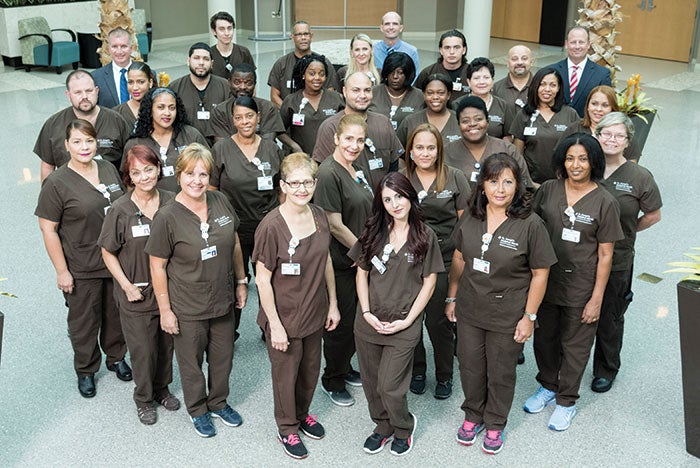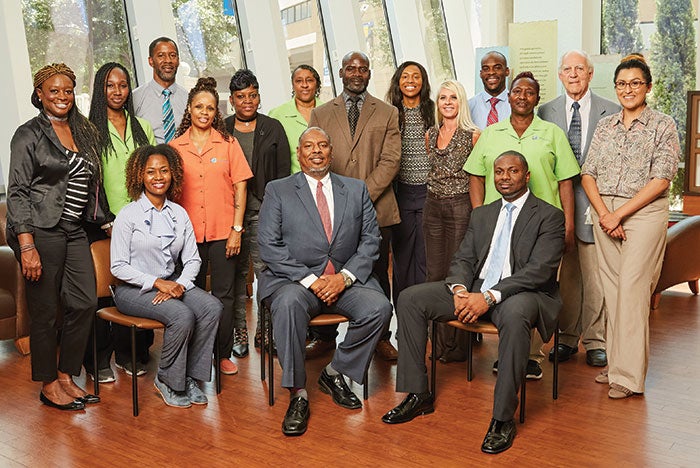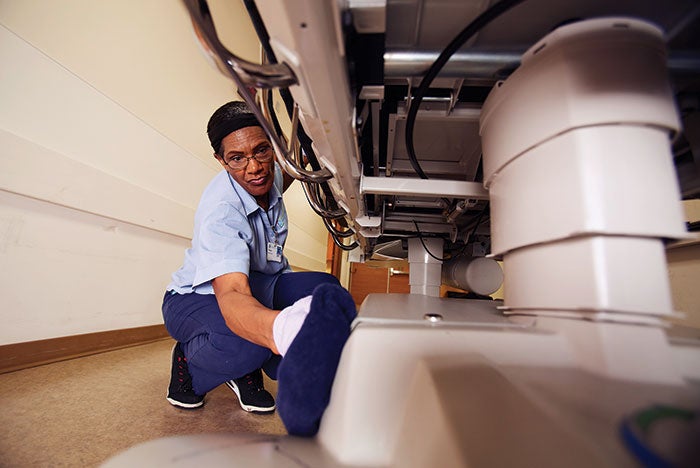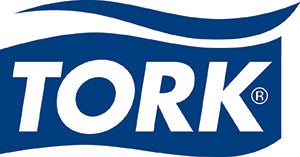JPS credits environmental services department success with teamwork

JPS Health Network includes a fully integrated partnership with Austin, Texas-based HHS, which provides environmental services at the JPS hospital.
Collaboration is a hallmark of the culture at JPS Health Network, Fort Worth, Texas. This is what makes the network’s environmental services department excel, says Louis Bedford III, executive director of environmental services, textile processing and transportation for JPS.
“Our culture here at JPS allows us to work in tandem with our nursing staff, with our doctors and with our administrators to do what is best for our patients,” says Bedford. “Everything we do is for the betterment of the patient. All of our teams are working together.”


WINNER PROFILE
BayCare's St. Joseph's Hospital-North focuses on certification and training
INTRO
Environmental Services Departments of the Year teams set safety standard
Collaboration is key
This includes a fully integrated partnership with Austin, Texas-based health facility service company HHS, which provides environmental services at the JPS hospital. As Bedford notes, facilities that outsource environmental services work often maintain a clear separation between the hospital and the service provider. This isn’t the case at JPS.
HHS personnel have a seat at the table as part of the health network’s interdepartmental teams, and are included in the annual JPS team member performance-incentive program and all JPS team member recognition activities. In 2016, for example, housekeeper Alice Borja received the John Peter Smith Excellence Award, the highest honor bestowed by the health network. JPS and HHS executives conduct joint monthly leadership meetings and an annual business performance review.
As far as patients are concerned, there’s no distinction between hospital staff and HHS staff. “They only see the JPS [environmental services] department,” Bedford says.
According to Bedford, this type of teamwork accounts for a recent improvement in JPS’s HCAHPS scores. Between 2015 and 2016, the health network rose from the 19th percentile (a top box score of 68.5) to the 41st percentile (a top box score of 71.6) for patient satisfaction with room cleanliness.
The improvement corresponds with an initiative at the hospital to include environmental services staff in nursing rounds. In 2015, environmental services team members performed 865 rounds; by the end of 2016, they had completed 44,000 rounds with nursing staff.

The JPS Health Network environmental services team includes (standing from left) Debbie Cockerham, patient ambassador; Felicia Waggoner, PM supervisor; Ronald Darden, assistant director; Wanda Haywood, PM supervisor; Sylvia Houston, patient ambassador; Debra Flemons, AM supervisor; William Crowell, general manager; Darcy Bedford, patient ambassador; Sylvia Norton, clinics operations manager; Al Miller, AM assistant director; Clara Duncan, AM supervisor; Ronald Steyn, AM assistant director; Maria Castro, HR manager; (seated from left) LaSandra Jordan, PM operations manager; Louis Bedford, executive director of environmental services/textile processing/transportation; and Craig Simon, assistant general manager.
“We’re doing this as a team,” Bedford explains. “The nurses are able to find out what the patients’ needs are from a clinical point of view and [environmental services] is able to find out what the patients’ needs are from a cleaning point of view.” Environmental services professionals put their names beside nurses’ names on the whiteboard in each patient’s room. “It seems to have had a positive impact on patients, because they know [that] if they have cleaning concerns, they can contact us,” says Bedford.
During the same 2015-2016 period, the environmental services department partnered with the infection control department on measures to implement best practices for infection prevention, such as swab testing sterile areas. Sterile rooms are tested daily for adenosine triphosphate (ATP), the presence of which can indicate improper cleaning of surfaces. The department’s first-pass rate for the swab tests rose from 78 percent in 2015 to 95 percent the following year. Test results are shared and discussed between nursing and environmental services staff members at monthly infection-prevention meetings.
The environmental services department is collaborating with the nursing, quality and laboratory departments on another interdepartmental team to improve hand hygiene at the hospital. The CHOMP (Clean Hands Obliterate Medical Problems) team leadership engagement project at JPS worked to identify procedural issues that were negatively impacting overall hand hygiene compliance at the facility.
The team chose two patient units on which to test performance-improvement ideas. These include the use of a computerized system to track when specific hand-hygiene devices are changed out (previously, refills had been inconsistent), as well as secret-shopper types of visual monitoring for hand-hygiene compliance at the patient room.
An intense focus on the basics of patient room disinfection by the environmental services department has played an important role in reducing the rate of health care-acquired infections at JPS, Bedford says. In 2016, the health network’s standardized infection ratio for methicillin-resistant Staphylococcus aureus (MRSA) was 0.386, significantly lower than the Texas state average of 0.883.
To ensure that patient rooms are properly cleaned and disinfected, the ATP swab testing performed by the infection-prevention department is coupled with performance improvement inspections by environmental services managers. Inspection frequency rose nearly 50 percent between 2015 and 2016, from 14,614 inspections to 21,482 inspections.
Particularly in rooms where pathogens like MRSA and Clostridium difficile have been present, “a manager will go back in that room to validate that cleaning was done properly, to help make sure that we do not have any reccurence in those locations,” Bedford explains.
Using technology
Managers can track these inspections on iPads using the Salesforce customer relationship management (CRM) platform’s mobile application. This allows them to recognize immediately if an employee needs extra mentoring or training. “We’re able to go in and get those data and we’re able to see how well our training is going,” says Bedford. “If we have some issues, we can go back and retrain our employees to make sure they’re cleaning the rooms properly.”
The management team can use the CRM app to run reports that show more detailed information to identify trends and create action plans to improve or sustain performance quality. Team member and manager training compliance data are tracked using the Salesforce internal learning management system.
The environmental services department developed a digital help ticket system that enables nursing and other hospital departments to submit work orders to environmental services. According to Bedford, this system was a major factor in improving the department’s internal district leadership satisfaction score from 74 percent in 2015 to 82 percent in 2016.

Cheryl Brookins cleans a gurney, demonstrating a focus on the basics of infection prevention.
As part of the help ticket system, work orders can include a time frame during which the cleaning issue needs to be addressed.
“Our housekeepers know our daily cleaning schedules, they know the things they’re assigned to do, but if a special project comes up and a department is asking us to go in and scrub their floors every three weeks, we can put that in the work order system so it automatically comes up every three weeks,” Bedford explains.
Incidental tasks, such as cleaning up a spill, can be entered into the system as well. Once tasks are finished, they are marked as complete so the individual who entered the work order can see that the matter has been resolved.
Recycling efforts
Environmental services staff members are part of JPS’s interdepartmental green committee, which is tasked to find new and improved ways to recycle and reduce landfill disposables.
Last year, the committee increased cardboard recycling at the health system by 351 percent over the previous year, from 120,000 pounds to 420,000 pounds. The 300,000 pounds of material diverted from the landfill represented an increased annual revenue of $36,200.
“We now have a compactor that’s dedicated to nothing but cardboard,” says Bedford. “We collect tons and tons of cardboard.”
In addition, the environmental services department works with medical device and equipment manufacturer Stryker Corp. to recycle clinical equipment like blood pressure cuffs and disposable stethoscopes. These items are bagged by environmental services staff upon patient discharge. Stryker picks up the items every two weeks and issues the health network a credit based on the amount collected. “We’re able to purchase new products for less because we’re able to get a credit for all the things we collect,” says Bedford.
‘Proud and honored’
The collaborative nature of JPS, ample training opportunities and a variety of performance-reward programs contribute to environmental services staff retention, which held at 42 percent last year, Bedford says.
“It’s all about the team effort. It’s all about what we’re all trying to do to make sure that we’re taking care of the patients here,” he notes. “We make sure staff get training, we make sure they feel comfortable before we put them out in an area by themselves. And then we applaud and we recognize employees who do well.”
Team members receive gift cards for every 30 days the entire team is injury-
free. The health network’s WOW/VIP program enables colleagues at the hospital to award one another with gift cards for exceptional performance, and each month the HHS Tango program gives people who go above and beyond in providing high-quality service $30 gift cards that can be used at more than 5,000 vendors.
Each business quarter, environmental services hosts a party for the entire department to celebrate meeting or exceeding departmental performance metrics. Hospital administration and departmental leadership also attend these gatherings to recognize the accomplishments of the whole team.
Being named the Environmental Services Department of the Year is another cause for celebration. “We are very, very proud and honored that we were recognized,” says Bedford.
Amy Eagle is a freelance journalist based in Homewood, Ill., who specializes in health care-related topics. She is a regular contributor to Health Facilities Management.



